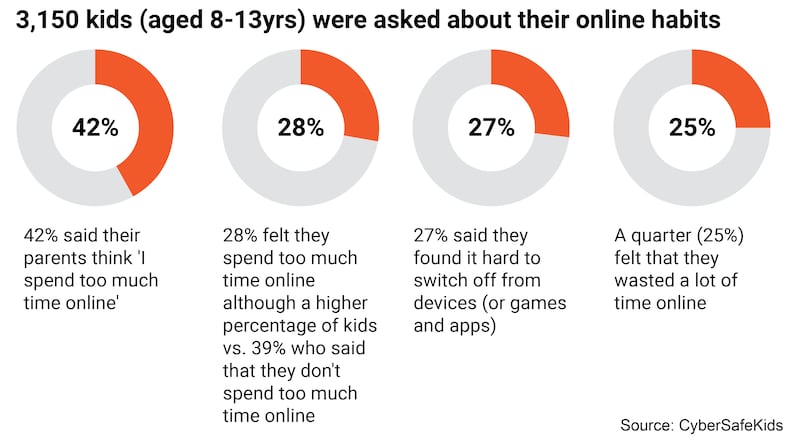Families are being urged to “take back control” of how much time children spend online on foot of new research which shows more than a quarter of children aged 8-13 years find it hard to switch off digital devices.
A survey of more than 3,150 primary-school-aged children by the online charity CyberSafeKids found that many young children spend significant amounts of time gaming (39 per cent), followed by watching YouTube videos (22 per cent) and using social media such as TikTok (17 per cent).
Among children as young as eight, messaging apps are surprisingly popular. Almost the same percentage of eight year olds (17 per cent) are using WhatsApp and iMessage as 12 year olds (18 per cent) and 13 year olds (19 per cent).

A high proportion of young children are using these platforms despite being under the minimum age requirement of 13.
READ MORE
Creative tools
While a wealth of creative tools is available online, very small numbers spend time creating things (3 per cent) or using the internet to look up information for projects.
When asked about their use of digital devices, 42 per cent of eight to 13 year olds said their parents think “I spend too much time online”.
More than a quarter (28 per cent) felt they spent too much time online, although a higher proportion (39 per cent) said that they did not spend too much time online.
Boys are significantly much more likely to spend their time online gaming than girls (61 per cent compared to 19 per cent of girls).
Girls, by contrast, spend a higher proportion of their time using social media (eg Snapchat or TikTok) at 25 per cent, watching YouTube videos (24 per cent), and chatting with friends (19 per cent).
Quality screen time
Dr Colman Noctor, a child psychotherapist, said it was important for parents to monitor quality screen time rather than just focusing on the length of screen time for kids.
“They are exposed to too much, too often and at too young an age,” he sad. “We need to shift that emphasis. Technology is not going anywhere, we just need to get better at taking back control of how much time we’re spending online, and calling out the gaming and social media companies for using opaque practices for holding our attention.”
Alex Cooney, chief executive of CyberSafeKids, said it is urging families to take a 24-hour “cyber break”.
“This is not about calling out the internet as a negative force in our lives – on the contrary, the internet is a tremendous resource for all of us and in so many ways a huge asset to our lives,” she said.
“There is, however, plenty of evidence to show that it is also pervasive and all-consuming in terms of our time and attention and it can be really difficult to ‘switch-off’.”
She said thousands of people had signed up to its campaign to “take time out, to reset the balance and to spend quality time doing fun stuff together offline”.













